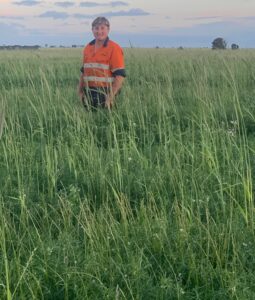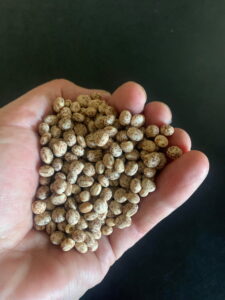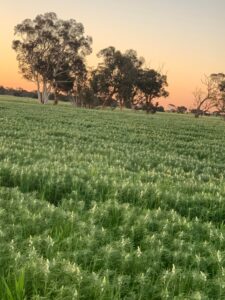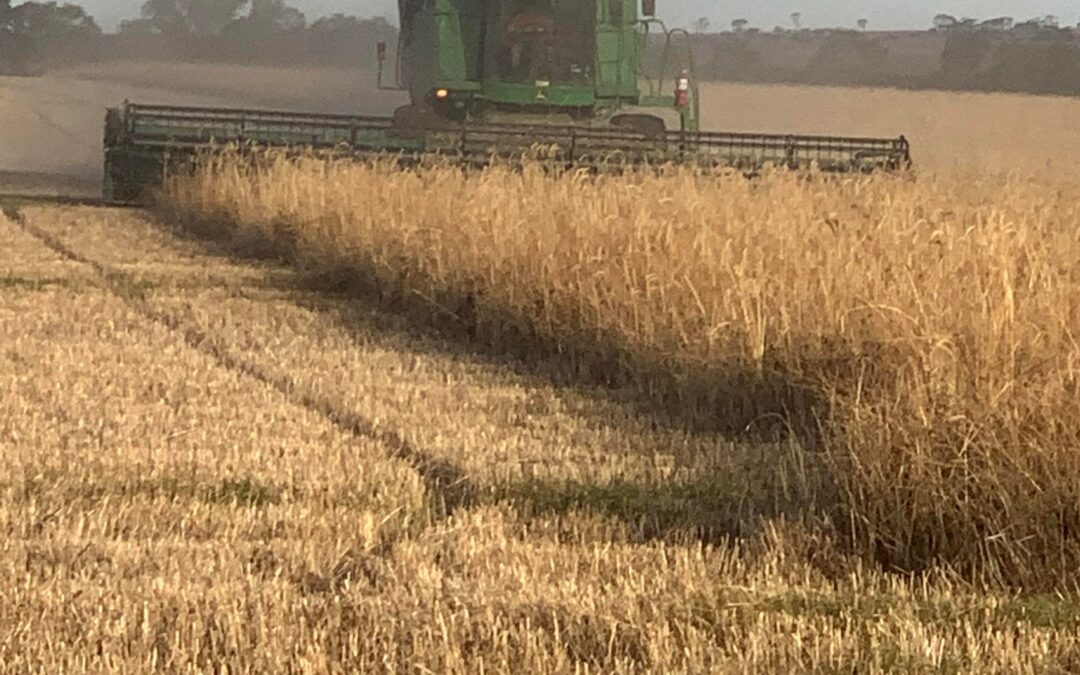Located just north of the Great Eastern Highway, approximately 1.5 hours’ drive east of Perth, Jodi and Ian James have established a thriving farm with multiple species companion cropping in the golden outback town of Meckering. Located on the traditional lands of the Ballardong Nyoongar people, the township of Meckering derives its name from an Aboriginal language and means ‘place of water’ or ‘moon on water’, and it is precisely this substance that led to the expansion of farmland in the area. Ian and Jodi’s farm is called Whare Koa, a Maori name meaning ‘happy home’.
Ian’s family were originally farming further north in the more marginal areas of the Wheatbelt, when as part of his farming education he traveled overseas on Agricultural Exchange to Sweden. While on exchange, he was badly injured in a severe car accident, totally disrupting his life. Ian spent a few years recovering overseas before making the decision to return home.
At this time in the early 1990s, he first heard about the potential impacts of climate change in the early 1990s. Climate predictions indicated that weather patterns and temperatures were to get drier and hotter, with the frequency, intensity and duration of hot spells likely to impact the landscape and the human and agricultural systems dependent on it. In a candid conversation with his father, Ian explained, “if it gets any drier or hotter here, we’re done for. We’ve got to buy land south before it gets too expensive.”
Shortly afterwards, the family purchased farmland in Meckering 200 km south, it was decided that Ian should settle on the Meckering farm while his mother and father would stay on the northern property for some years before later selling and retiring from farming.
The Meckering landscape is largely comprised of sand plains, flat with rolling shallow broad valleys and peppered with creeks. Ian refers to the low inherent fertility of the sands as ‘light country’, lacking the nutrients necessary to produce a healthy strong crop with sufficient yields. This is typically addressed in conventional systems by applying considerable doses of synthetic fertiliser. However, the quick draining habit of sandy soils makes it hard for the soil to hold onto the fertilisers applied.
“Fertilisers and chemicals are a mask. They’re just putting into the soil what the crop needs, but the soil is being robbed of what sustains it: organic matter and biological diversity,” says Ian.
When they first began farming in Meckering in the late 1990s, the James’ were following conventional best practice but they began to realise the limitations of this approach in such low-nutrient soil. By the time Jodi and Ian were married, it was becoming obvious that the intensification of land use under conventional cropping methods and long-term fertiliser application was depleting their soil further. Their farm lacked the scale to justify the investment in the large agricultural machinery and equipment necessary to support a conventional farming enterprise that would turn a modest profit. Yet their smaller equipment was turning their daily farming grind into a harder operation than it should be, and they were struggling to get through their routine farming activities.
After experiencing a couple of consecutive dry seasons, Ian could no longer ignore the changes in climatic conditions and their impact on their farming system and finances. The hotter seasons were becoming drier, the wet seasons shorter, and their struggles intensified with the cumulative effects of drier conditions, poor-quality soils and the low resilience of plants. Neighbouring farmers imparted their advice, “you need to spend more money on fertilisers and chemicals.”
 Cultivating opportunity from crisis
Cultivating opportunity from crisis
Ian and Jodi were already spending more money on chemical inputs than what they were earning, sliding deeper into debt with each passing year. A particularly bad year placed them on the precipice of financial ruin while their input bill had blown out beyond viability. Farming to the very brink of possibility and liability within a conventional agricultural system and failing to get sufficient yields in return, Jodi decided to explore a way in which to farm without the added cost of increasingly expensive inputs. Coming close to crisis instigated an ongoing pursuit of knowledge for organic and regenerative agricultural techniques and soil biology.
“It was tough at first, but we were committed to learning. We adapted, trialled and discovered new techniques,” recalls Ian.
With an imperative to secure the future of their farm, Ian and Jodi selected methods to improve soil health and fertility and reduce reliance on chemical fertilisers. Conversion to organic became a process of experimentation, observation, learning and reflection.
“Every year, our farm is improving, and it’s improving exponentially. Every year we see this low-fertility country getting stronger and stronger naturally. And we can see it visually: it darkens with the carbon. Organic soil carbon is the foundation of soil fertility.”
This experiential knowledge of building natural soil fertility was key to reducing their farm’s exposure to volatile input prices and ensuring their farm’s survival.
“One by one, farms around us were sold,” recalls Ian.
The issues he had noticed affected the whole industry.
“Many families in the district left farming and were gradually replaced by bigger operations, but we’re still here. Many of the farmers who said to me that we were going to go broke [pursuing organic agriculture] are now gone.”
Together, Ian and Jodi are continuing and improving the regeneration of their farming landscape. They employ multi-species cropping methods, planting grass crops, plus oats, rye, wheat, and also lupins and approximately three or four other species of legumes. Planting diverse and beneficial plants provides a food source for a broader range of soil biology, lifting the resilience and fertility of the land, improving the soil function, structure and water-holding capacity and continuing to value-add to the productivity of the landscape.
“The soil was pretty highly degraded because of past practices, but it has responded amazingly to biology and lupins love it. We worked out organics suits light land farming, and lupins in particular as part of a multi-species cropping program are the key to it. Lupins are yielding about twice as much as grass crops.”
For the love of lupins- the real regenerative legume
 With over 200 species, lupins are grown in a wide array of regions across the globe, ranging from the Mediterranean to the southwestern United States, northern Mexico to both eastern and western parts of Australia. Two varieties of lupin are most commonly grown in Australia, with the majority of lupin production occurring in the winter/spring rain-fed parts of southwestern Western Australia. As a high-protein grain, it is commonly grown and harvested for human and animal consumption, yet it also holds many advantages in both cropping and mixed cropping–livestock farming systems.
With over 200 species, lupins are grown in a wide array of regions across the globe, ranging from the Mediterranean to the southwestern United States, northern Mexico to both eastern and western parts of Australia. Two varieties of lupin are most commonly grown in Australia, with the majority of lupin production occurring in the winter/spring rain-fed parts of southwestern Western Australia. As a high-protein grain, it is commonly grown and harvested for human and animal consumption, yet it also holds many advantages in both cropping and mixed cropping–livestock farming systems.
Lupins produce a significant nitrogen contribution for subsequent crops and can increase the availability of phosphorus in soils. They provide a disease break for cereal crops and can help control grass weeds within cropping sequences. Other benefits include improved soil structure, increased water use efficiency of subsequent crops, and increased yields of cereals following lupin crop rotation, particularly when grown in sandy soils.
“Lupins are a fantastic tool for an organic farmer, because chemical nitrogen, although widely available and fairly cheap, is not an organic substance. It kills biology and basically destroys sustainably. Whereas lupins create a perfect environment for other crops to grow, like grass crops,” notes Ian.
A member of the pea family, lupins produce an assorted palette of pea-like flowers with bold spikes of vibrant purples, pinks and blues, rich reds and yellows, or crisp, clean whites. When the lupins come into bloom on Jodi and Ian’s farm, the whole paddock is transformed into a sea of brilliant white. When pulled from the ground, the symbiotic relationship between lupins and the nitrogen-fixing soil bacteria rhizobia is visually evident in the small nodules that form around the plant’s roots. The increase in microbial activity and associated improvement in soil structure also maximises the retention of moisture in the soil, an important element in building the adaptive capacity of their farm in light of shorter wetter seasons and climatic variability.
In addition to a healthier farm, Ian and Jodi are now spending a lot less on (organic) farm inputs while receiving a price premium for their organic products. Ian estimates that a conventional farmer would have to produce roughly four times their yield to make the same profit.
Finding solutions to systemic industry problems
While Ian and Jodi have generated many on-farm improvements, limitations in existing organic industry structures and networks made it difficult to access markets within Australia to sell their lupins. While a few organic dairy farmers within Western Australia were purchasing their lupins to form part of their animal feed, Western Australia has a relatively small organic domestic market when compared to the eastern states. Ian discovered that the supply chain for many organic products is relatively undeveloped, particularly for many broadacre products, and there are significant problems relating to a lack of scale in the handling of grains.
Freight costs to the eastern states were also proving to be prohibitively high, particularly with the additional financial pressure points that COVID-19 and the energy crisis have added. Ian and Jodi were looking at a freight bill that amounted to two-thirds of their total farm gate price for their lupins, making it non viable to sell their product into the Eastern States.
The ORCA project endeavours to unlock some of these barriers by looking at better market opportunities for organic producers that allow more resilient profitability and increase the transparency of these grains direct from farm to end processor. The wider connections and network facilitated by the ORCA project allowed Ian and Jodi to interact with other producers and processors to tap into demand for their lupins and organise a shipping chain that was affordable and viable. ORCA has now facilitated its first shipment of over 100 tonnes of organic lupins from Western Australia to Melbourne and Brisbane. And the original ORCA Riverina project has been expanded to include ORCA producers in Western Australia thanks to funding from the Sustainable Table Fund
Another barrier endemic to the Western Australian organic industry is a lack of processors suitable for organic grains. Western Australia only contributes around 10 percent of the total Australian production of organic livestock, vegetable, fruit and grains, so the current demand is not high enough for processors to warrant the costs associated with organic management and certification for processors. Whereas organic agricultural production and demand are much higher across the Eastern States. “Through ORCA’s assistance, we’ve managed to tap into that processor capacity which is available in the east,” says Ian.
“Through ORCA’s assistance, we’ve managed to tap into that processor capacity which is available in the east,” says Ian.
He believes these supply chain bottlenecks can be overcome through greater collaboration and investment.
“We need to band together as organic farmers in an organised manner to share and leverage our capital and asset base and share the costs and organisational capacity to set up processing and storage capacity and store grains in a way where our premium organic product is not going to deteriorate.”
“We have to be able to attract government assistance and strategic investment, get organised, and work together to set up suitable infrastructure and put the structures in place, so we can delegate management to people who hold expertise in these [processing and value-adding] techniques and skills and put those people into places, so we (producers) can get back to the business of farming. ORCA enables us to do just that”
The future lies in farmer-to-farmer knowledge exchange
Ian believes that local farmer knowledge is a valuable resource to reorient modern agriculture towards more sustainable and resilient paths of development and draw in the next generation of farmers. A lot of this knowledge has been lost over time with the spreading of the conventional agricultural paradigm and the standardised, highly industrialised external input solutions it puts forth. Rebuilding formal and informal knowledge exchange and learning between farmers is central to strengthening agricultural sustainability and resilience.
Innovative farmers like Ian and Jodi are using high-performance organic and regenerative landscape management methods and fighting the trend of the continued degradation of the landscape and soil through conventional agricultural methods with their heavy reliance on external inputs. They are demonstrating sustainable, regenerative practices on their land, as are many organic, biodynamic and regenerative farmers across Australia. With relevant policies and incentives, these practices could be extended successfully and quickly to involve a significant number of Australia’s current and next-generation farmers. Whilst there are always opportunities to learn more, enough is already known to take action now.
“The real wealth we have is our knowledge. And we can share that with the next generation and with current farmers that are frustrated by their lack of market access and price premiums. That’s what we should be doing as farmers. That’s how we can capture the value of organic farming: by focusing the energy into teaching the next generation and current farmers.”
Written by Eva Perroni as part of the ORCA project

